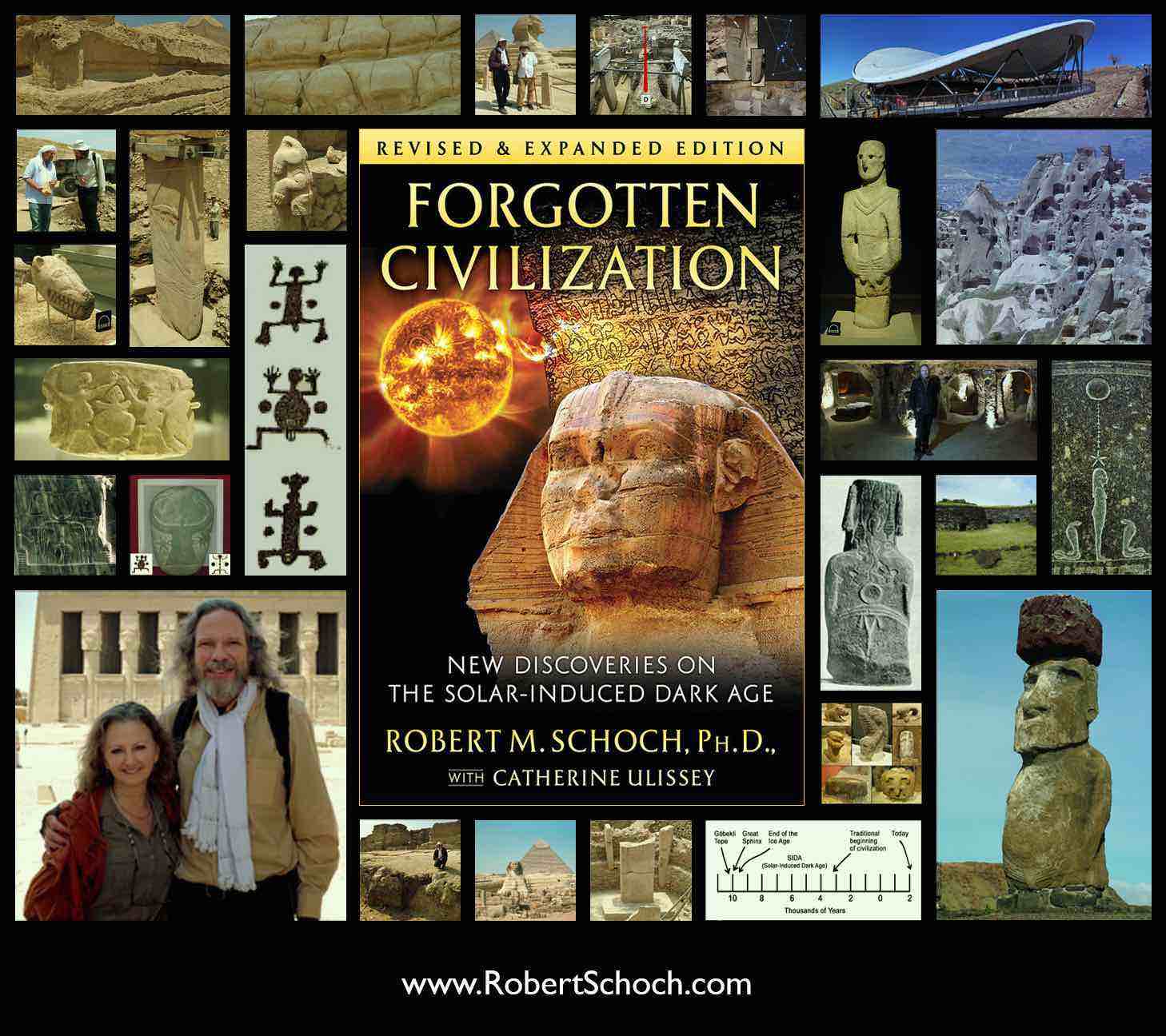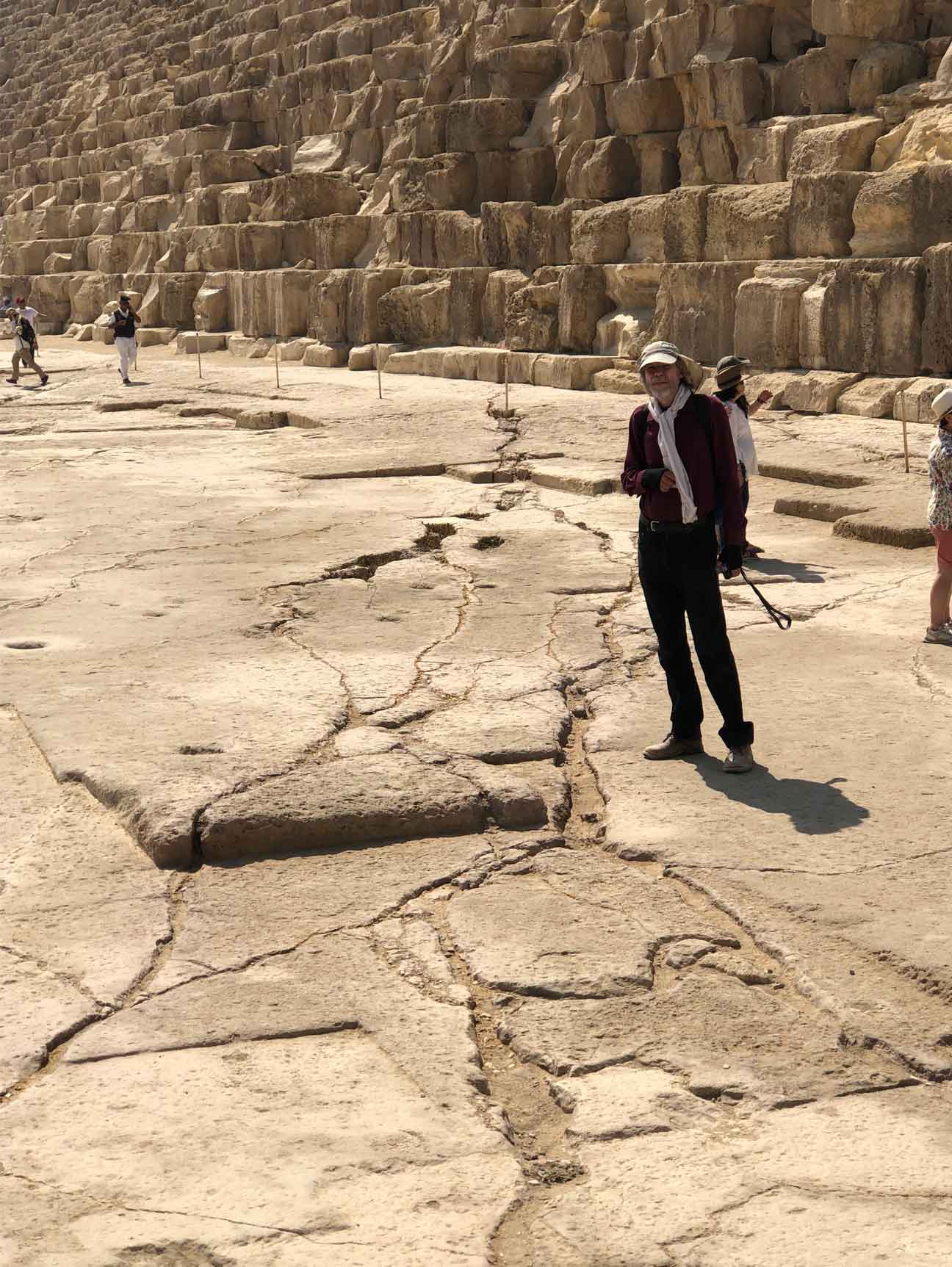
Vitrification. Lichtenberg Patterns. The Giza Pyramids Mark the Location of Ancient Lightning Strikes.
By Robert M. Schoch, Ph.D., and Catherine Ulissey
Posted 4 October 2023
My wife certainly keeps me on my toes (metaphorically speaking) with her scientific observations and hypotheses, and this presentation adds to the examples. As oxygen breathes energy into a flame, Katie has set my research ablaze (I use that word because the topic at hand is high-energy plasma) almost since the day we met in 2007. I believe she has made important and challenging contributions to our understanding of ancient Egypt and ancient civilization more generally. By the end of this article, I hope you will understand why.
Pursuing the Scientific Evidence (for over thirty years)
Anyone who has walked the Giza Plateau knows that the ground there is pitted, topographically uneven, and replete with gouges and channels, cracks and broken rocks (some massive). I have had the privilege of studying this extraordinary location for more than thirty years, visiting it countless times, and each time I do something extraordinary becomes visible to me, something I never saw before. With each revelation I feel a window into the remote past opens wider. What I see is a little scary at times, and certainly humbling; it is also endlessly compelling. I now have no doubt that this location was – and still is to millions of people for myriad reasons – hallowed ground. My research demonstrates that this is a place where the Sun, in the ancient world recognized as the Divine (God, or a god), touched the Earth, but that touch has not always been gentle. This site has been venerated for millennia; much further back in time than most Egyptologists are willing to acknowledge, and much further back than our current civilization extends. Unfortunately, though, we appear to be trampling away the precious evidence. By examining the science, perhaps we can better understand the magnitude of what is before us at Giza, how old the monuments there actually are, and how far back in time civilization extends. We are not the first civilization to walk this Earth, just as ancient texts and voices from history assert.
How It All Started
In the 1990s, and at the invitation of the independent Egyptologist John Anthony West (1932—2018), I traveled to Egypt to examine the Great Sphinx from a geological perspective. Inspired by an observation made by philosopher, mathematician, and student of ancient Egypt R. A. Schwaller de Lubicz (1887—1961) that the Great Sphinx appeared to be weathered by water and not by wind and sand as has traditionally been believed, West felt that an important contribution to humanity could be made by pursuing this matter further. That said, he needed a trained geologist to help him make his case, for the implications of a water-weathered Sphinx are profound. I happened to be the scientist West engaged. For more on my education and training, please see the About page of this website. And for a humorous account of how West and I met, you might enjoy this short video clip of him introducing me at a 2007 conference (this latter link is external).
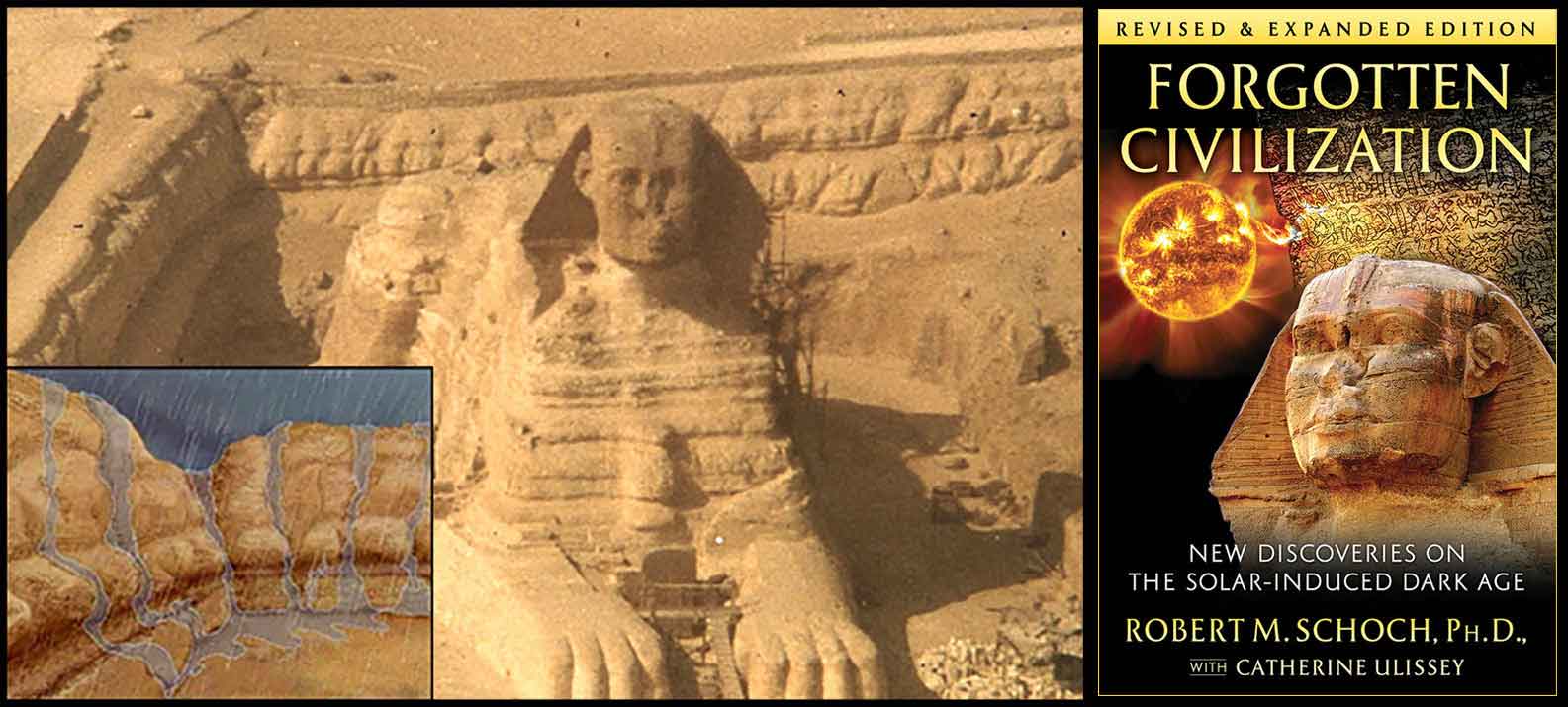
In a nutshell, the Great Sphinx has been weathered extensively by water. The problem with this simple observation is that the monument's location is on the edge of the Sahara Desert, which has experienced hyper-arid conditions for more than 5,000 years, longer that our current civilization has existed. This makes the monument's standard dating of circa 2500 BCE impossible. Our (West's, mine, and Dr. Thomas Dobecki's) extensive analyses of the monument initially pushed its dating back by thousands of years, to the period of 7000–5000 BCE. Based on my latest analysis of all of the available data, I now push the date for the origins of the Sphinx back to before the end of the last ice age, circa 9700 BCE (note that the head was re-carved during dynastic times).
West and I first presented evidence of a water-weathered Great Sphinx at the 1991 Geological Society of America (GSA) annual meeting. It received an overwhelmingly positive reception by the attending geologists. Subsequently, Egyptologists learned of our work and became outraged. I can understand why: the science we put forth challenged the Egyptological timeline as well as the historical timeline for the rise of civilization. Egyptologists scrambled to organize a debate on the age of the Great Sphinx at the 1992 American Association for the Advancement of Science (AAAS) meeting. The primary argument put forth by those representing Egyptology was that nowhere else on Earth was there another example of megalithic construction at such an early date. This was true at the time, but circumstances have now changed dramatically. Emerging from an artificially created mountain (now declared an UNESCO World Heritage Site) is the megalithic complex of Göbekli Tepe. This article is not about that site, so I will only discuss it briefly here. For more information regarding my work on Göbekli Tepe (following many visits, extensive research, and on-site discussions with the late Dr. Klaus Schmidt), please see my book Forgotten Civilization: New Discoveries on the Solar-Induced Dark Age (this is an external link to the 2nd, revised and expanded, 2021 edition).
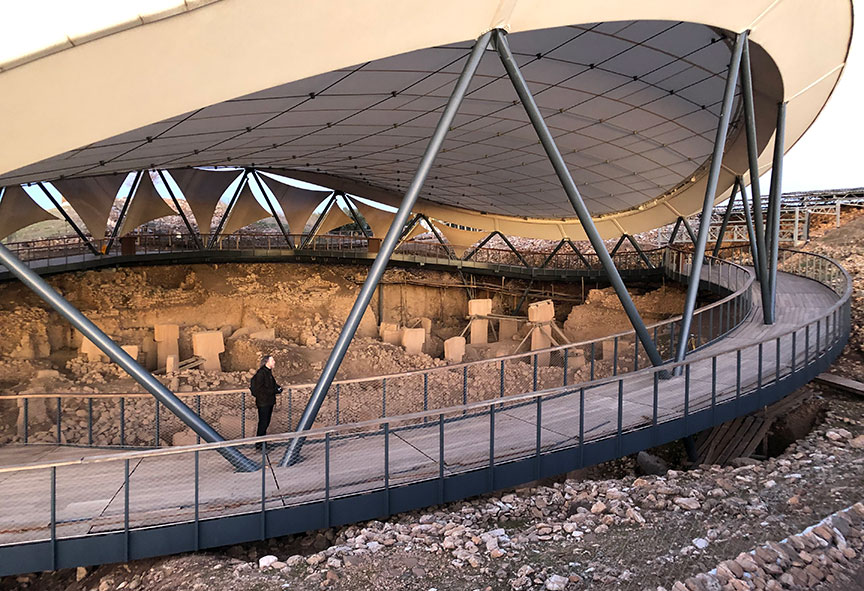
Göbekli Tepe is large, megalithic, located near the ancient city of Urfa, quite possibly the oldest continuously inhabited city on Earth (and possibly the one associated with this archaeological complex), and its symbols and/or symbolic notation (at least what has been revealed so far; only a small portion of the site has been excavated) reappears thousands of years later in Hittite writing (for more details, see the discussion in Forgotten Civilization). These are the hallmarks of civilization, only they occur 6000 years before civilization is supposed to have arisen according to the traditional chronology. Something to note is that Göbekli Tepe was not abandoned at the end of the last ice age; rather it was carefully and intentionally buried – its megaliths seemingly broken by some cataclysm, then repositioned in ancient times, then packed into position with smaller rocks, and then finally the whole site was covered with small rubble (fill), creating the mountain or Pot-bellied Hill we now call Göbekli Tepe. It is a remarkable site, and resounding corroboration that civilization, high culture, goes back at least 12,000 years.
The end of the last ice age brought tremendous changes on our planet. Glaciers melted, ocean levels rose, large mammals went extinct. What could cause this sudden end of glacial conditions along with the simultaneous decimation of high culture circa 9700 BCE? I pondered this question for years, but the standard explanations seemed unconvincing. Then, in 2010, Katie made an astounding observation.
Dr. Anthony Peratt is one of the preeminent plasma physicists of our time, studying our Sun, stars, and high-energy plasma discharges using sophisticated equipment at Los Alamos National Laboratory. One aspect of his research revealed that plasma at high intensity takes on distinct and diagnostic shapes. Some examples he offers are stick-figured men with bird's heads, stick-figured men with dots on their sides (the dots indicative of synchrotron radiation), cascading cylindrical shapes (donuts / plasmoids), etc. Subsequently, he noticed that ancient rock art, petroglyphs (he identified examples in more than 130 countries), seem to mirror those distinct shapes, leading him to the conclusion that ancient people in prehistory witnessed a major solar outburst and recorded what they saw, plasma in the sky, swirling in our magnetosphere (think of the aurora borealis and/or aurora australis on steroids), and they recorded those shapes on rock. Katie's observation (made in 2010), which expands his work, is that the glyphs of Easter Island’s rongorongo script mirror Dr. Peratt's global plasma petroglyphs. Needless to say, I was struck as if by plasma itself. (I used this phrase in Forgotten Civilization, but it merits reiteration now – and in the 2021 edition of the book I mention that a member of Dr. Peratt's research team confirmed to us in writing that in their assessment the observation is correct; they had made the discovery years prior but did not publish it.) This observation left me certain the Sun was the missing piece of the puzzle that brings the ancient mysteries we are discussing here together – and since 2010, I have focused my research in this direction, pouring through ice and sediment core data, lunar data, dendrochronology, and more.

Our Sun exploded at the end of the last ice age. Call it a micronova. This is what explains Earth's snapping out of the last ice age (as the data mentioned above confirms). The searing heat caused dramatic and precipitous ocean level rises – a great flood, if you will. The moisture pumped into the atmosphere from this scorching event caused torrential and protracted rain, which explains the great rains that fell upon the Great Sphinx in prehistory. I am a paleontologist as well as a geologist and geophysicist, and I have studied the fossil record of Earth. Many large mammals go extinct at this time. The radiation from a massive solar outburst explains why. Humans are large mammals; they are also resourceful. They built extensive underground shelters, like those seen in the Cappadocia region of Turkey. Here a large pocket of humanity survived what Katie and I call a Solar-Induced Dark Age (SIDA) only to re-emerge 6000 years later in the same general area (and other pockets of humanity survived elsewhere around the globe) amidst megalithic monuments belonging to an earlier period, a golden and forgotten age. Ancient Egyptians referred to Zep Tepi, a golden age. I do not understand why modern Egyptologists ignore the evidence for it, especially since Egypt holds the motherload.
Returning to Giza
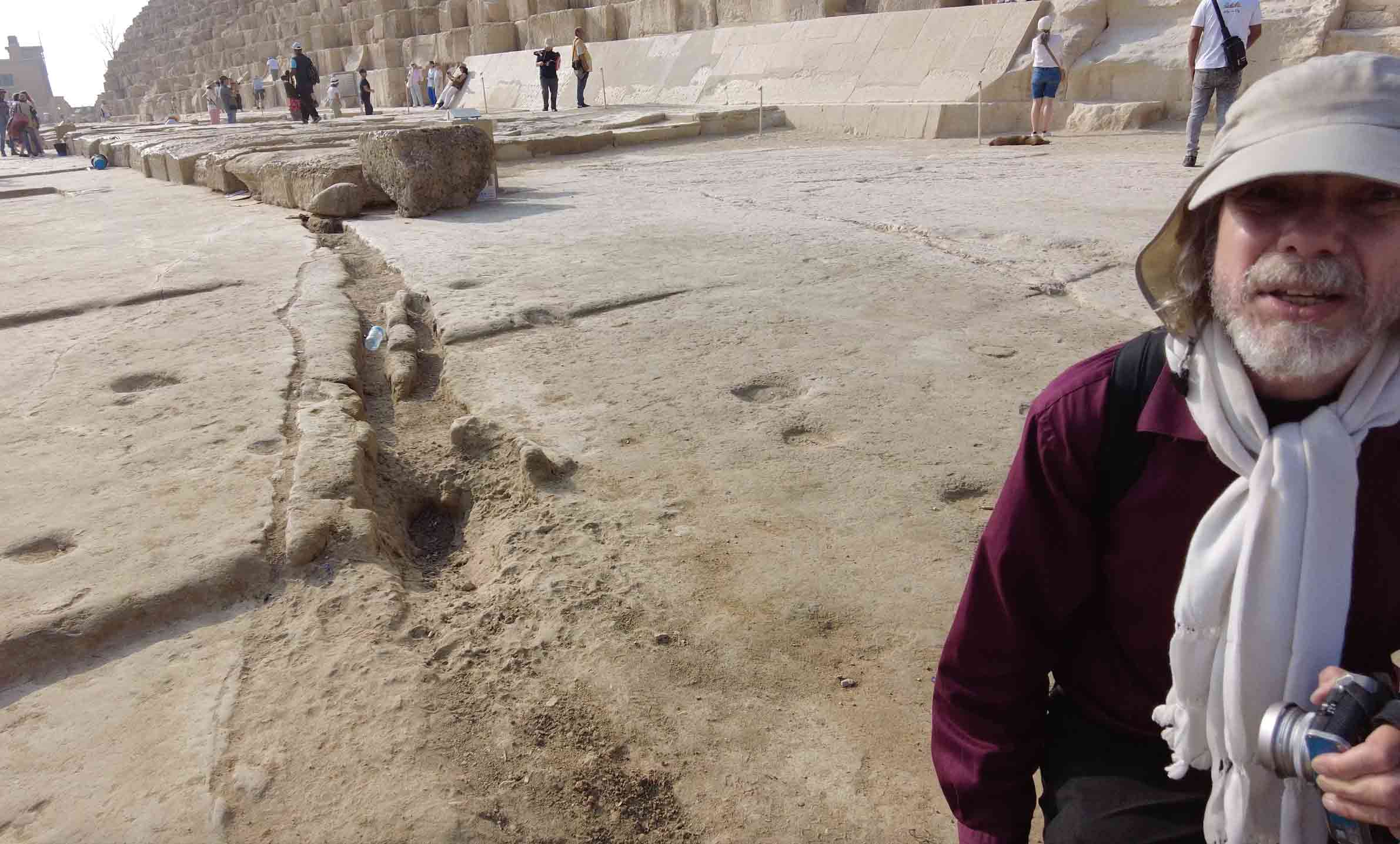
I am convinced that the Giza Plateau is one location where plasma from this solar event touched ground level. Vitrification (the turning of stone to crude natural glass due to extreme temperatures) can be seen extensively there, and I have studied it for years (it was first brought to my attention by Mohamed Ibrahim and Yousef Awyan). It was during the summer of 2023 that Katie noticed Lichtenberg patterns seeming to emerge from beneath both the Great Pyramid and also the Second Pyramid. Her observation was again electrifying to me, and I believe she is correct.
Lichtenberg figures, first described scientifically in 1777 by Georg Christoph Lichtenberg
(1742 – 1799), are dendritic tree-like branching patterns that form when high voltage electrical
discharges hit a relatively non-conducting surface – such as the limestone surface of the Giza
Plateau. Like many electrical plasma phenomena, Lichtenberg phenomena occur at scales spanning
numerous orders of magnitude, from microscopic to planetary-scale, or even greater. On the Giza
Plateau Lichtenberg patterns are on the order of hundreds of meters in extent, as they appear to
be emanating outward from under the Great Pyramid (the base is approximately 231 meters on each
side) and the Second Pyramid (the base is approximately 215.5 meters on each side). Such patterns,
on such a scale, could be due to incredibly intense lightning strikes. However, typical atmospheric
lightning that we witness in the present day is not strong enough to create such large and
widespread scarring; instead, I believe what we are observing is the result of a major solar
outburst that drove plasma, originating from our Sun, down through our atmosphere and
magnetosphere to ground level where it hit as huge lightning bolts
. I hypothesize that
the pyramids were built on, and to mark, the center or focal points of major plasma strikes,
places where the Sun touched the Earth
(so to speak), making this a sacred and revered site.
These dendritic patterns currently appear as cracks
or channels
in the rock, the
significance of which is easily overlooked.
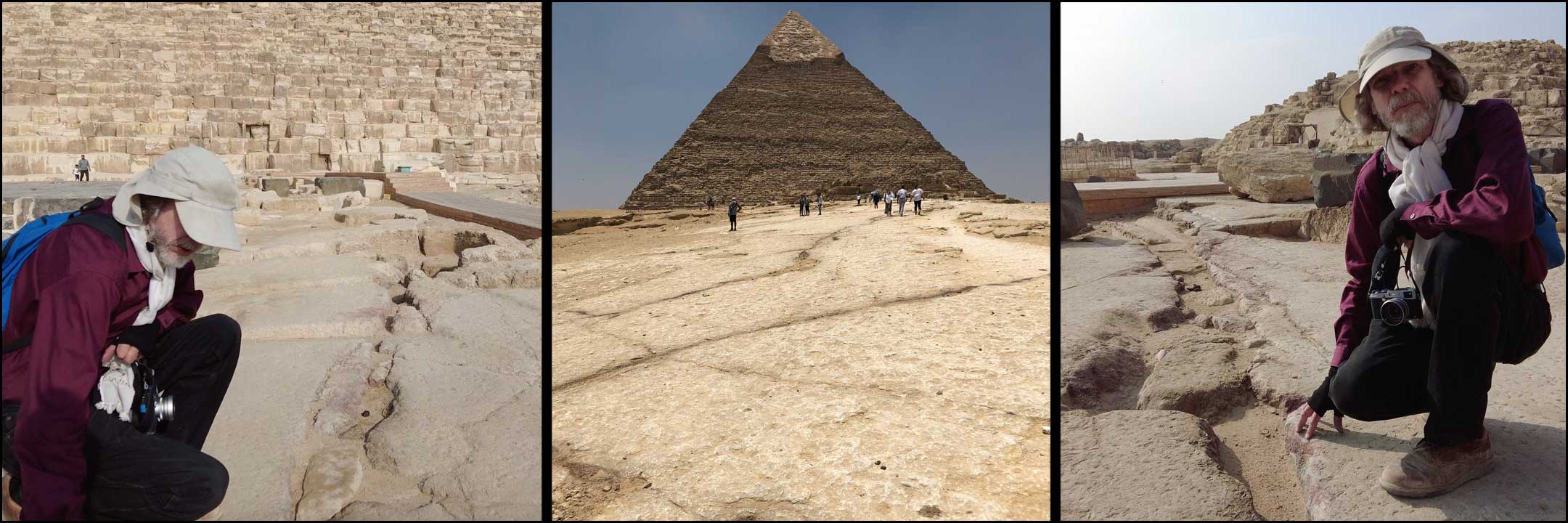
With such ideas in mind, walking around the pyramids and down to the Sphinx, the countless
channels that gouge the Plateau made sense. I suspect they are the remains of massive Lichtenberg
patterns that were created when scorching plasma struck the Plateau. Evidence of the scorching
can be seen in various veins of vitrification that permeate the Plateau. It can also be seen
beneath the massive blocks that line the ground to the east of the Second Pyramid. (Please
see the banner image at the top of this page as an illustration.) However, many of the
channels are now empty, and some people even refer to them as water channels
or drainage
channels. Yes, water may collect in these channels during the rare occasions when it rains
at Giza (remember, Giza is on the edge of the Sahara), but this does not mean they originated
as drainage or water channels. One might ask, if they truly record Lichtenberg patterns, why are
these channels not all filled with burnt and vitrified rock and natural scoria today? In many
instances vitrified
rock can be relatively fragile and unstable, thus easily subject to surface atmospheric weathering
and erosion. This, combined with thousands of years of being trampled upon by humans, horses,
camels, and whatnot, has led to the degradation and destruction of much of the original vitrified
rock with the result that only empty channels remain. The locations where original vitrification
is best preserved is where it penetrated deeply down into the rock and has subsequently been
exposed in vertical cross sections, whether those cross sections were created by later natural
erosion or by human activity cutting into the bedrock. Significantly, in places there is evidence
(such as near the eastern face of the Second Pyramid) that the ancient people did not simply build
over or on top of vitrified rock, but they apparently were intent on preserving it by carving the
overlying rock to match or marry
the underlying very ancient vitrified rock – it would have
been much easier and more efficient
to have simply smoothed out the underlying vitrified rock
(again, please see the banner image of this webpage for the visual example). However,
if this was considered a sacred and revered site, then one can understand why the extra effort was
made to preserve the vitrified rock, the physical evidence of the divine represented by the Sun
touching this site.
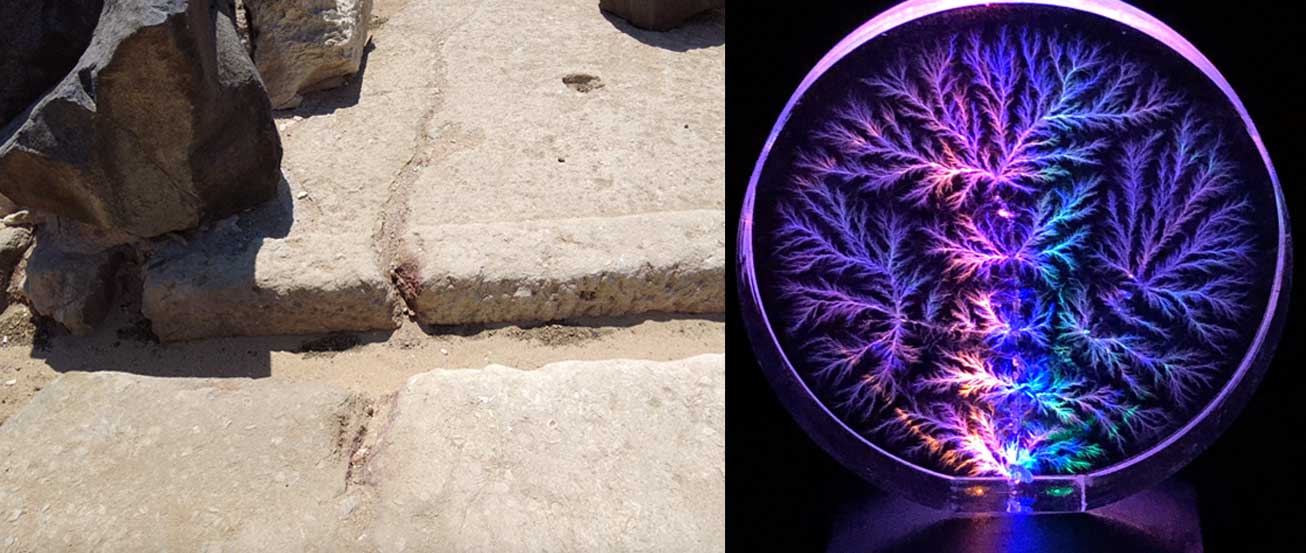
This vitrified rock and scoria beneath the overlying human-made structures, and the Lichtenberg patterns emanating out from beneath the Great Pyramid and the Second Pyramid specifically, suggest that these structures were constructed subsequent to the earth-shattering plasma event caused by a solar outburst. There is no account of such an event in our historical record, which can lead us to hypothesize that the pyramids were constructed in prehistory. I suspect that the origins of these pyramids date back many millennia prior to dynastic Egypt; subsequently, like the Sphinx, they were re-appropriated, reworked, added to, and reused by later peoples, including the dynastic Egyptians.
One additional feature to note, so as to further separate dendritic branching from water channels, is that dendritic branching from electrical discharges can make very sudden/sharp right angles. Water does not generally flow in this manner. See the accompanying composite image of electrical discharge in acrylic as compared to dendritic right angles found on the Giza Plateau.
Here I must comment briefly on the Inventory Stela. Discovered at Giza, the so-called Inventory Stela,
alternatively known as the Stela of Khufu’s Daughter, also records a lightning strike. Although
the actual stela dates to the seventh or sixth century BCE, it purports to be a copy of an Old
Kingdom text. According to the Inventory Stela, the Great Sphinx was already in existence during
the reign of Khufu, the supposed builder of the Great Pyramid. Indeed, Khufu is credited with
repairing the Sphinx after it was struck by lightning (see further discussion in
Forgotten Civilization; and again, I recommend the 2021 edition). How much evidence will it
take to convince the Egyptological community that their timeline, and indeed the entire timeline
for civilization on Earth, needs revision? We now have literal mountains, and in multiple
locations! (I suspect that the Giza Plateau may itself be a giant plasma blister
. Its scalloped
edges seem to hint at this, but it would need much further on-site investigation and I am not
holding my breath on this, though I of course always remain hopeful.)
Other Examples
Giza is not the only site where lightning strikes
are associated with megalithic structures.
Another example that has been documented in the literature by a team led by C. Richard Bates
(University of St. Andrews, Fife, Scotland) is the site of the Callanish (in Gaelic, Calanais)
Stones of Scotland, dating to over 5,900 years ago (how far back in time the site dates is
uncertain; see further discussion, with references, in the 2021 edition of Forgotten Civilization,
pp. 343-344). Another example which I have studied firsthand, which preserves the natural vitrified
rock, can be seen at the Temple of Mnajdra on Malta. This example in an entryway megalith
(a threshold stone) conveys the importance of the Sun to the temple and perhaps to the micronova
it unleashed.
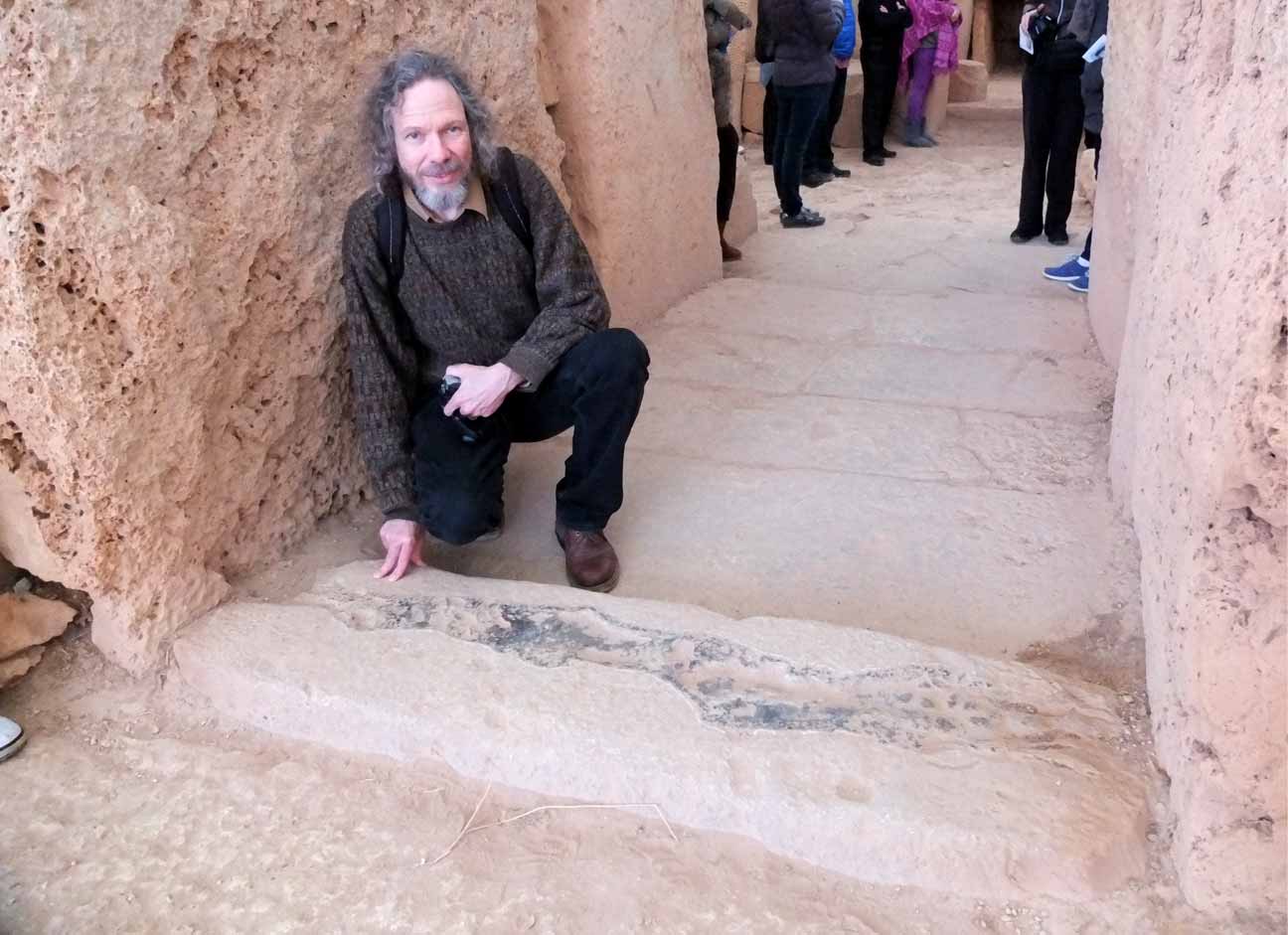
Lightning versus Hydrothermal Mineralization?
(Addition uploaded 5 October 2023)
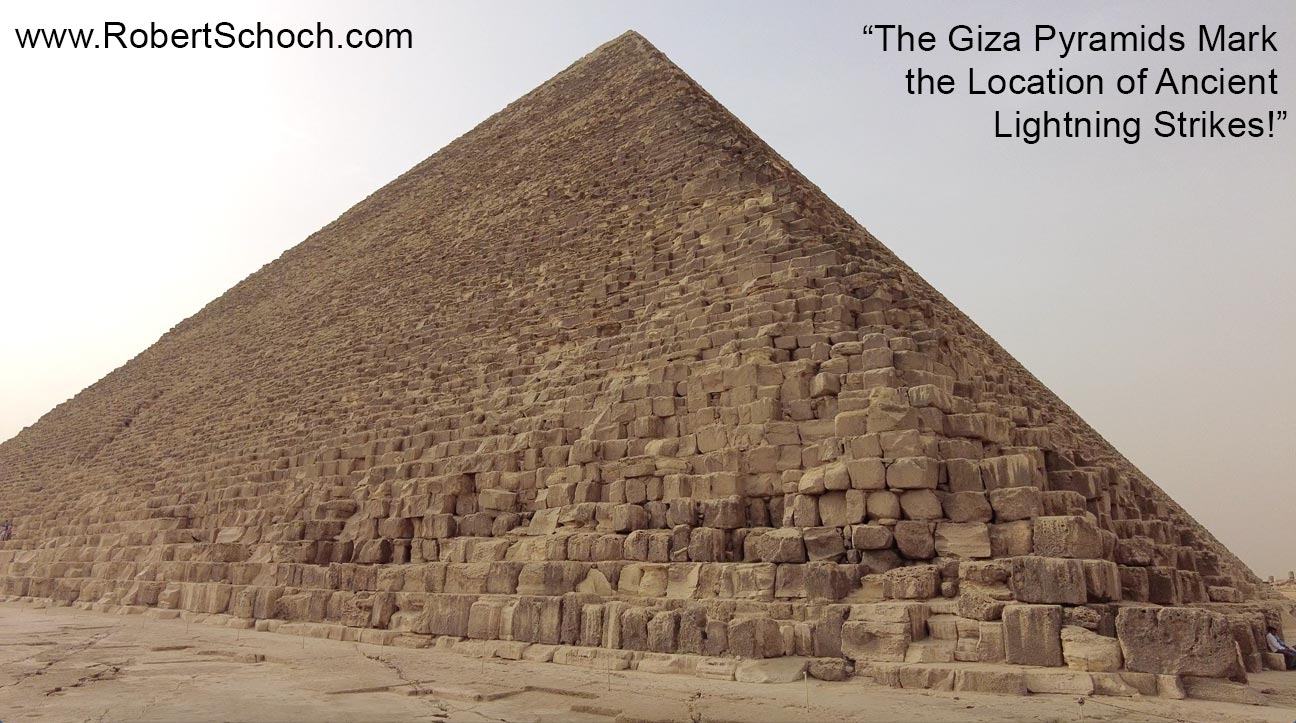
One critic of this hypothesis has suggested that all we are looking at are intrusive iron-rich
hydrothermal deposits, which are often found in limestone and other sedimentary deposits. Briefly,
I would point out one does not preclude the other; that is, in my assessment, both can (and do)
occur on the Giza Plateau. One can observe iron-rich layers in cross-sections of the limestone.
In any specific case, one must address the possible causative agents and the possible source of
heat, not simply assume everything represents classic
hydrothermal features. We should consider
various possibilities regarding the source of heat causing the formation of surficial features
that follow Lichtenberg patterns on the surface that just happen to emanate from the two pyramids.
What is the source of the heat? Did it come from below (for instance, magma in prehistoric times)
or from above (for instance, lightning / plasma discharges at the end of the last ice age)? The
ancient dynastic Egyptians acknowledged and recognized ancient lightning strikes / thunderbolts
on the Plateau – perhaps they understood what had happened at Giza.
In analogy to the discussion in the last paragraph, not all craters on Earth (or other planetary
bodies, including various moons and other objects in our solar system and beyond) are the same. Not
all craters were formed by the same mechanism. Undoubtedly, given that we can observe such activity
in the present day, some ancient craters are the remains of volcanic calderas or other igneous
phenomena (including hydrothermal buildup of steam that can be released explosively). Craters can
form when deep methane accumulations work their way to the surface. Sinkholes, in some cases on
massive scales, can form craters. Some craters are the result of physical impactors, such as meteors,
comets, asteroids, and the like. And some craters are the result of electrical discharges and plasma
strikes, as I explore in more detail in Forgotten Civilization. To attribute all craters on
Earth or other planetary bodies to a single cause is a mistake. Likewise, to attribute and label all
mineral deposits with superficially similar morphologies as hydrothermal
and assume therefore
that they cannot possibly have anything to do with lightning or plasma strikes is a mistake. To cite
another analogy in the history of geology, a century ago there was a common consensus (which was
considered beyond debate) among many professional geologists that the positions of the continents
are fixed. Certainly, the continents cannot move! Yet today the concept of moving continents, in the
form of plate tectonics, is a major paradigm of modern geology.
(This paragraph added on 7 October 2023.)
In Summation
The Lichtenberg patterns observed on the Giza Plateau constitute another line of evidence regarding the events that ended the last ice age, circa 9700 BCE. Our planet was hit by the destructive forces of a massive solar explosion, a micronova, that unleashed coronal mass ejections (CMEs) and associated phenomena. This scorching event caused the rapid melting of glacial ice sheets, global and catastrophic flooding, torrential rains from the moisture pumped into the atmosphere (thus the heavy rains that fell upon and scarred/fissured the Great Sphinx and its Enclosure). Many large mammals went extinct due to high levels of radiation, including some human populations. Survivors sought shelter in caves and beneath the surface – the underground cities, which we believe originated at this time (although they were reused later), in Cappadocia are a prime example. We suspect that the areas in Egypt now referred to as the Valleys of the Kings, Queens, and Nobles were other such structures which had their origins during this remote period (and were likewise enlarged and reused by later peoples, including the dynastic Egyptians). The high civilizations of the late ice age were decimated. Those who survived witnessed a golden age of high knowledge and sophistication coming to an end. These were neither simple nor primitive hunters and gatherers. Survivors did what they could to preserve the greatness of their monuments and history by intentionally physically packing and burying their temples (these structures may not have been temples in a modern sense, but something more, perhaps akin to modern university complexes, libraries, and museums – that is, centers of knowledge). The survivors attempted to record and preserve the knowledge of this golden age that the ancient Egyptians referred to as Zep Tepi.

ABOUT THE AUTHORS
Robert M. Schoch, Ph.D.
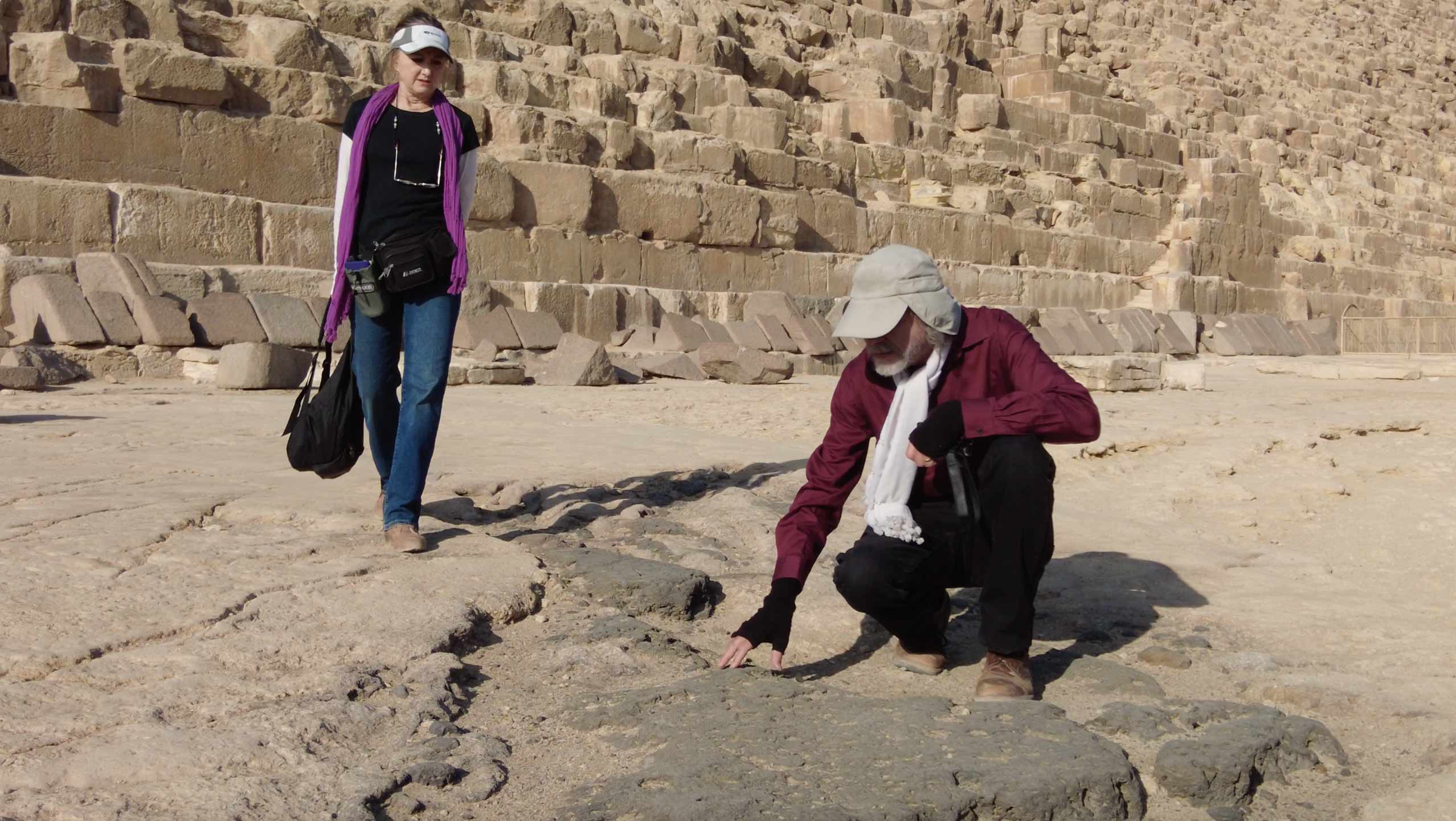
A full-time faculty member at Boston University since 1984, Dr. Schoch earned his Ph.D. (1983) in Geology and Geophysics at Yale University. In the early 1990s, Dr. Schoch’s geological analyses of the Great Sphinx demonstrated that the statue is thousands of years older than the conventional dating of 2500 BCE, bringing him international fame and recognition. His assertion that there was an earlier cycle of civilization before civilization is supposed to have existed, though attacked by many members of the Egyptological and archaeological establishments, has stood the test of time. Stunning confirmation of Dr. Schoch’s view has come with the discovery of the highly sophisticated 12,000-year-old site of Göbekli Tepe in southeastern Turkey. In recent years, further data and reanalysis of his previous work has led Dr. Schoch to conclude that the origins of the Sphinx go back millennia further than he first proposed; he now places the origins of the Great Sphinx at about 12,000 years ago. Dr. Schoch is the author of numerous books and articles, both academic and popular, including Forgotten Civilization: New Discoveries on the Solar-Induced Dark Age (with Catherine Ulissey; Inner Traditions, 2021; this is a revised and expanded edition of the original 2012 edition). He has reached audiences around the world via television, radio, live presentations, and the Internet (the Emmy-winning documentary The Mystery of the Sphinx, which first aired on NBC, remains a favorite among audiences). In recognition of his scientific contributions to the study of ancient civilizations, in 2014 Dr. Schoch was awarded the title of Honorary Professor of the Nikola Vaptsarov Naval Academy in Varna, Bulgaria. Dr. Schoch’s website is: www.robertschoch.com . For more information, please see the About page of this website.
Catherine Ulissey
Katie found her early years shaped by dance. Classically and conservatory-trained by the age of sixteen, she began performing professionally (and internationally) with ballet companies, including the Maryland Ballet and The Eliot Feld Ballet Company in NYC. As Ballet Mistress and a soloist performer with Eliot Feld's company, she had the opportunity to work with other prominent New York choreographers such as David Parsons and the Pilobolus team. Subsequently, Katie performed in a number of Broadway musicals, including the Tony Award-winning New York Shakespeare Festival production of The Mystery of Edwin Drood and the original cast of Andrew Lloyd Webber's The Phantom of the Opera. In 2002, following a 20-year stage career, Katie attended Emerson College in Boston, earning a B.A. in Visual and Media Arts (summa cum laude). Post-graduation, she has stayed connected to her dance roots by teaching ballet – formerly for the Harvard University Dance Program (for sixteen years) and the Boston Ballet School, and more recently for Wellesley College, where she has instructed students since 2005. Katie spent her early childhood growing up in Saudi Arabia and there, through her parents, was introduced to and fell in love with the ancient mysteries. She met her husband, Dr. Schoch, while attending a conference on the topic in 2007. In January 2010 (with the help of friends and dignitaries), they were married on Easter Island. Inspired by her husband’s research from the moment she learned of it, she is enormously proud to now contribute to it. In addition to her contributions presented in Forgotten Civilization, Katie has worked with her husband and illustrator Lisa M. Perkins to create a children's book series focusing on the ancient mysteries. Book one of this series, Adriana’s Ancient Mysteries: The Great Sphinx, has been published in both German (in 2021) and Italian (in 2022) language editions. She is currently seeking an English-language publisher for the book(s). For more on Katie's work, please see either the Publications page of this website, her page, or her more detailed professional bio posted on the Wellesley College website.
